Stegosaurus stenops, S. ungulatus, S. sulcatus
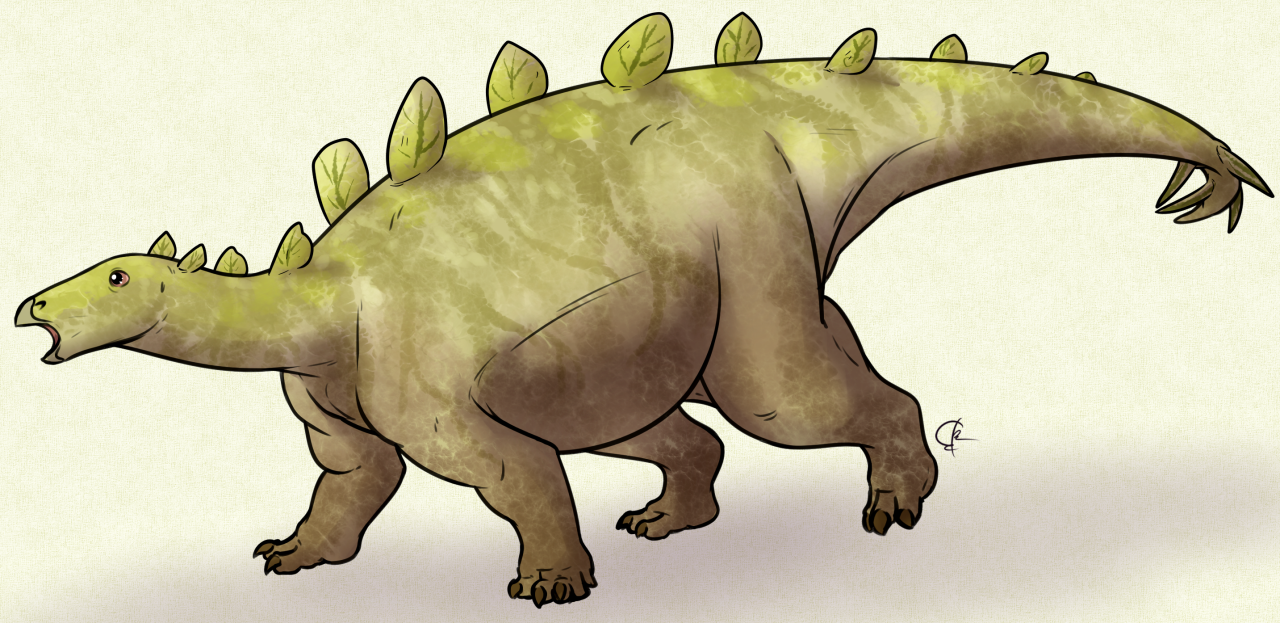
By José Carlos Cortés on @ryuukibart
Name: Stegosaurus stenops, S. ungulatus, S. sulcatus
Name Meaning: Covered Reptile
First Described: 1877
Described By: Marsh
Classification: Dinosauria, Ornithischia, Genasauria, Thyreophora, Eurypoda, Stegosauria, Stegosauridae, Stegosaurinae
Here it is - the big one. The most famous Stegosaur, Stegosaurus itself. It is well known, well talked about, and one of the “big four” dinosaurs - along with Tyrannosaurus, Apatosaurus/Brontosaurus, and Triceratops. So what was Stegosaurus? Well, it was a very large Stegosaur from the Morrison Formation of Colorado and Wyoming, one of the best known dinosaur environments. It lived about 155 to 150 million years ago, in the Tithonian age of the Late Jurassic, and it is known from many specimens and multiple species of animal. In fact, three species are still considered valid: S. stenops, which is the best known from at least 50 skeletons; S. ungulatus, which might be synonymous with S. stenops, and was the longest known species; and S. sulcatus, which had furrowed spikes with large bases.
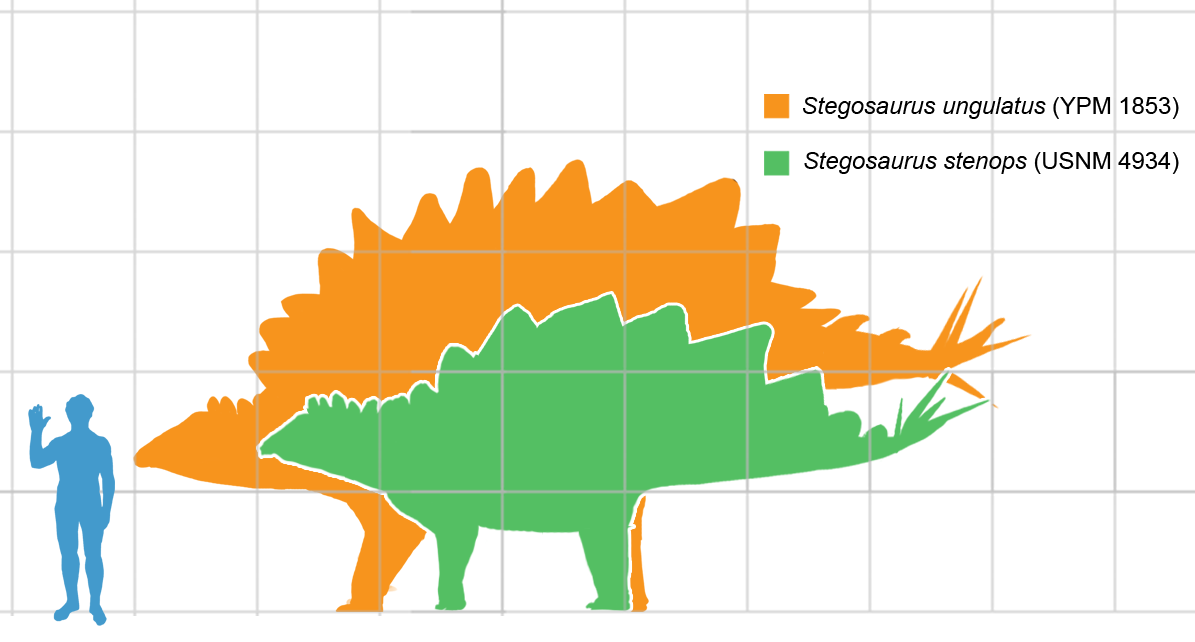
By Levi Bernardo Martínez, CC BY-SA 3.0
Stegosaurs varied considerably in size, and were able to grow up to 9 meters long, but many other specimens are considerably smaller, and Stegosaurs in general were not the largest herbivores in their environment (sauropods were). Juvenile specimens are also known, with one subadult being about 4.6 meters long. Stegosaurus had a long and narrow skull without teeth in the front of the jaw, and its other teeth were small, triangular and flat, which they used to grind their food. The teeth would have been completely hidden and it might have had a considerable beak along its jaws to allow it to snip off vegetation. Even though it had a very large body, it did have a very small braincase, indicating that its brain was probably only the size of a dog’s brain; however, it probably did not have a “second brain” in its body. Rather, modern birds have higher neuronal density than most mammals, leading to their higher levels of intelligence; though Stegosaurus would not have been extremely intelligent, a decent hypothesis for how it made up for its small brain to body size ratio exists in the idea of it having a higher neuronal density, allowing for more synaptic connections and thus more brainpower for less size.
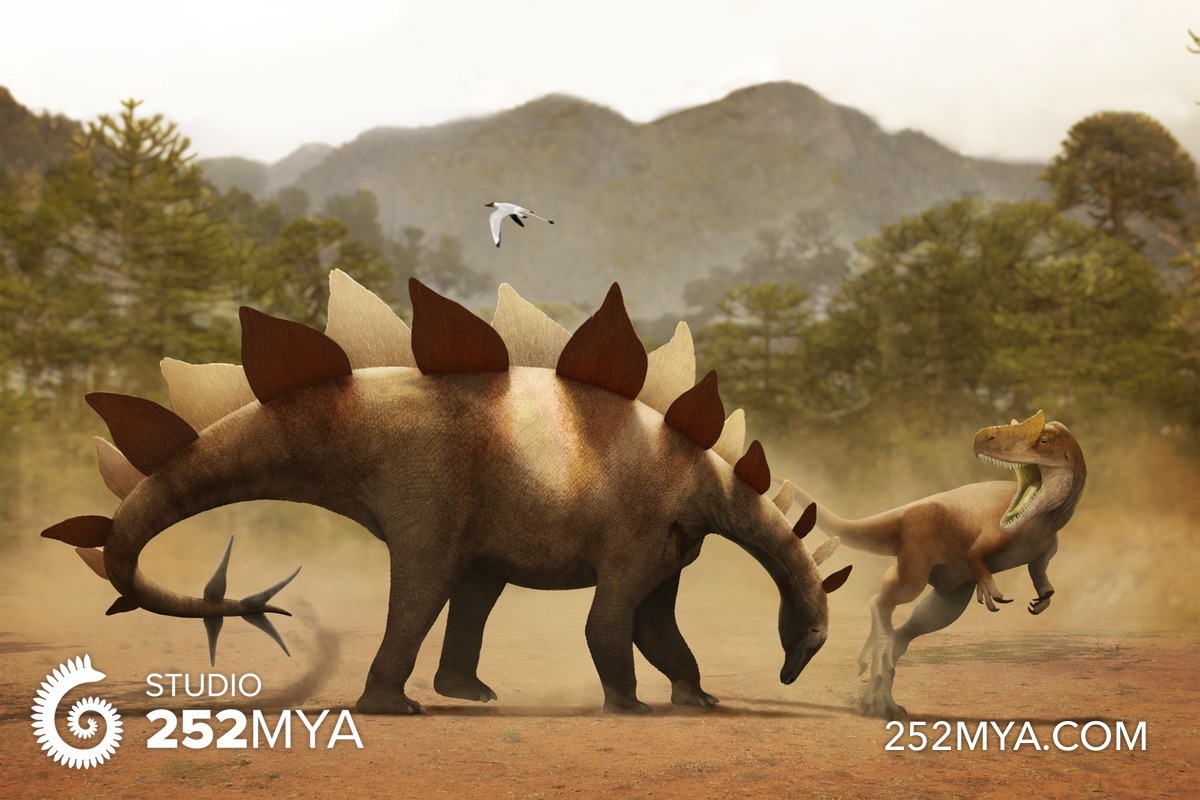
By Julio Lacerda, @paleoart, used with permission from @252mya‘s database.
As for what diet can be assumed from its distinctive teeth, its jaws were only able to move up and down, and thus it would not have been an extensive grinder of food - and it also did not have gastroliths to grind up food in its stomach either. Many hypotheses for how it fed have been proposed, including eating low level fruit and plants, or raising on its hind legs to reach higher vegetation; it seems to have had a bite similar in strength to modern herbivores like cattle and sheep, so it may have fed on woodier, tougher plants in addition to low lying vegetation. This uniqueness in both its feeding level and method of ingestion would have allowed it to carve out a separate niche in its Morrison environment from the many other herbivores present.
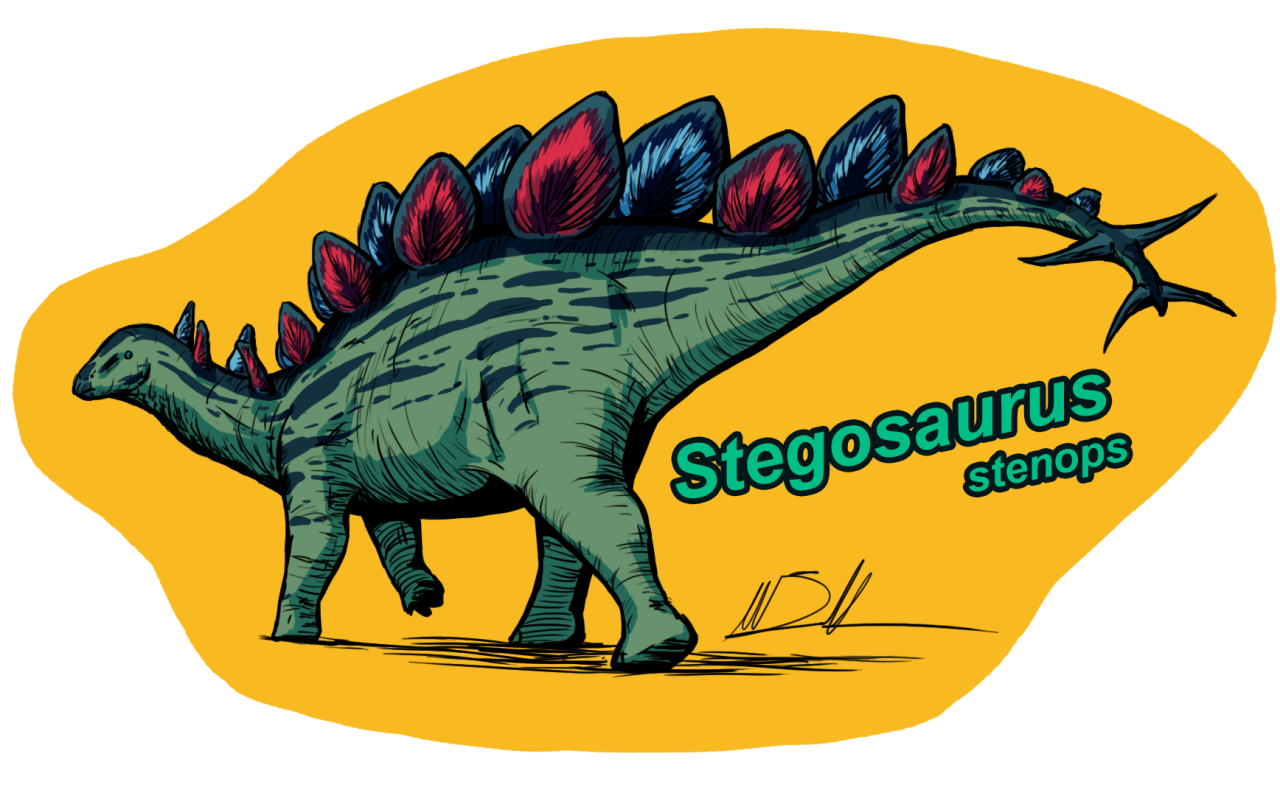
By Maya Jade on @hauntedmech
Though often depicted with a fairly short neck, the most completely known specimen of Stegosaurus, “Sophie”, indicates otherwise - though not as intense as MIragaia, Stegosaurus had a fairly elongate neck, which also would have affected its feeding range. Though it had very short forelimbs, it would not have been bipedal, but rather a slow moving quadruped, moving at about 6 to 7 kilometers per hour. Tracks of the animal show multiple baby Stegosaurus moving together with adults and an older juvenile moving with them, indicating that Stegosaurus may have lived in herds with individuals of multiple ages - maybe even family groups. Juveniles are preserved of this genus and show the general growth patterns - babies had smaller plates and spikes, which grew at a slower rate than the rest of the skeleton, but did continue to grow after the skeleton was done growing.
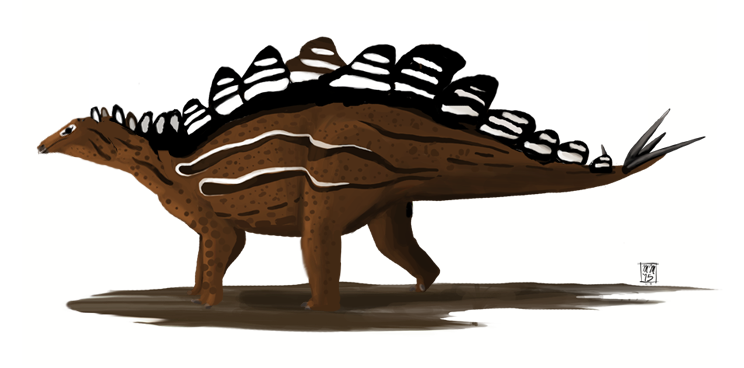
By Matt Martyniuk, CC BY-SA 4.0
So what about those plates? What were they for? First thought to be armor, they seem to have been too fragile for that; and though they may have had some sort of thermoregulatory function, they would not have been able to majorly contribute to the body-temperature regulation of Stegosaurus - the plates simply weren’t big enough to have a major impact on the animal’s growth (in addition, it is entirely possible that Stegosaurus was endothermic or at least mesothermic, making extensive directed thermoregulation as seen in ectothermic animals rather unnecessary). As such, the likely function of the plates seems to be display and identification. They were oriented upright, in two rows, and possibly alternating, allowing for much surface area of the plates to be visible to other animals; they could have been used to attract mates, or even have been flushed with blood to change the color when threatened with a predator, leading to the animal appearing even larger and more threatening.
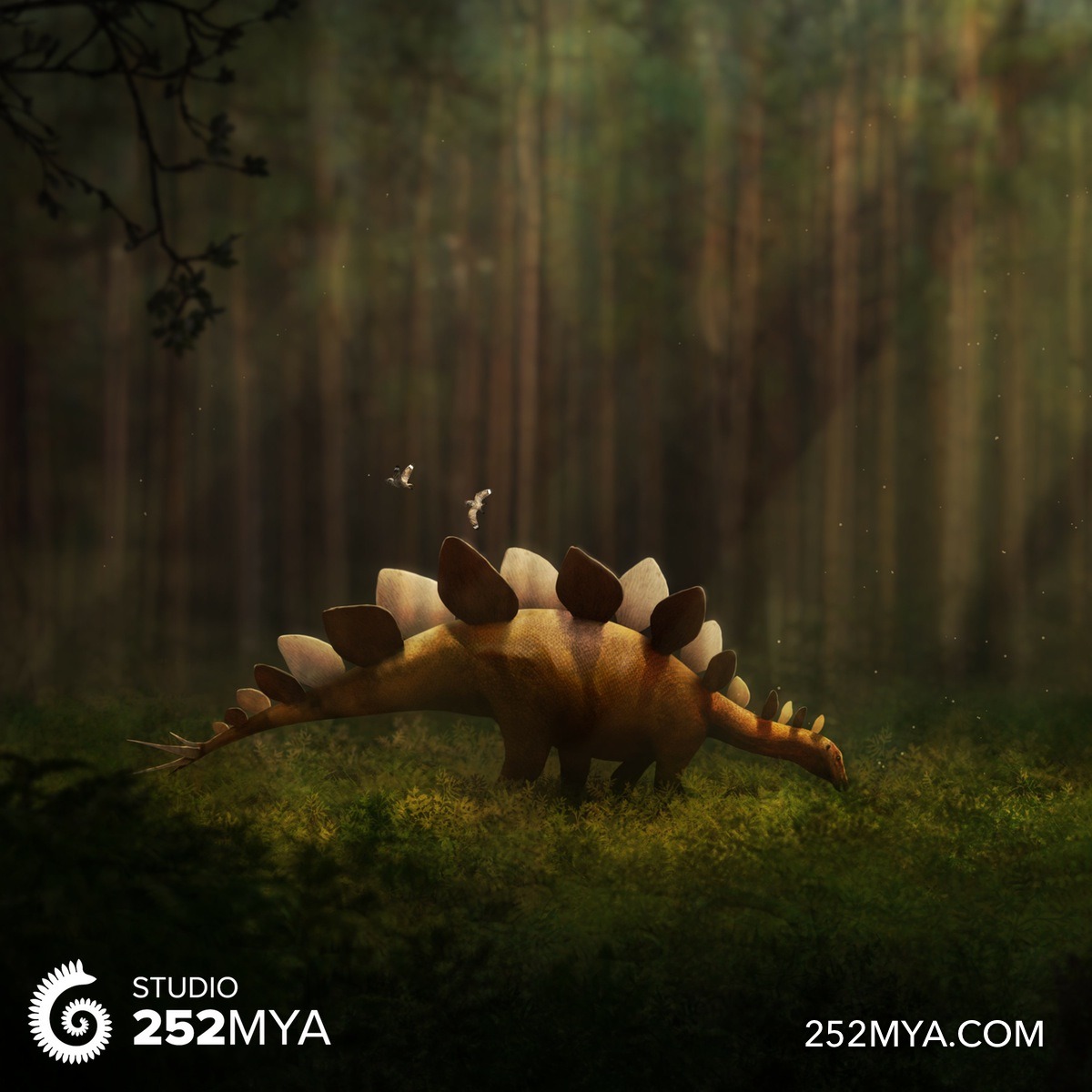
By Julio Lacerda, @paleoart, used with permission from @252mya‘s database.
The plates varied extensively, with the number going between 17 and 22 of them; they were not directly attached to the skeleton but rather to the skin of the animal. They also varied extensively in size and were oftentimes mirror images of each other, much like the right and left hands of people. As for the spikes, there were four of them, with the structure called a “thagomizer”; preserved spikes show extensive trauma-related damage, indicating that they used them for defense; wound holes found in Allosaurus tails indicates that they were indeed used against them. They might have protruded primarily horizontally from the tail, however this is still under some debate and discussion. To get a better look at its skeleton, feel free to download this 3D Model of “Sophie”, which really lets you see the shape and proportions of the animal (can only be used in Adobe Reader).

By Jack Wood on @thewoodparable
It lived in a semiarid environment alongside a very complex community of dinosaurs and other animals. There were distinct dry and wet seasons with varied vegetation including forests and fern savannas. It lived alongside such dinosaurs as the sauropods Brachiosaurus, Apatosaurus, Diplodocus, Brontosaurus, Camarasaurus, and Barosaurus, which would have been the dominant herbivores around it. Other Ornithischians it lived with were primarily Neornithischians, such as Camptosaurus, Dryosaurus, Othnielosaurus, and Drinker, though it did live alongside the ankylosaur Gargoyleosaurus. There were many predators in its region as well, from small ones such as Coelurus, Tanycolagreus, Stokesosaurus, and Ornitholestes, to large predators such as Marshosaurus, Ceratosaurus, Torvosaurus, Saurophaganax, and of course, Allosaurus, many of which probably preyed upon Stegosaurus. Though, of course, with all of its defenses, it would have been a very hard animal to catch.
Sources:
D’Emic, M. D. 2015. Comment on “Evidence for mesothermy in dinosaurs.” Science 348 (6238): 982.
Grady, J. M, B. J. Enquist, E. Dettweiler-Robinson, N. A. Wright, F. A. Smith. 2014. Evidence for mesothermy in dinosaurs. Science 344 (6189): 1268-1272.
Maidment, S. C. R., C. Brassey, P. M. Barrett. The postcranial skeleton of an exceptionally complete individual of the plated dinosaur Stegosaurus stenops (Dinosauria: Thyreophora) from the Upper Jurassic Morrison Formation of Wyoming, USA. PLoS One 10 (1): e0138352.
Olkowicz, S., M. Kocourek, R. K. Lučan, M. Portes, W. T. Fitch, S. Herculano-Houzel, P. Nėmec. 2016. Birds have primate-like numbers of neurons in the forebrain. PNAS 113 (26): 7255-7260.
https://en.wikipedia.org/wiki/Stegosaurus#Paleoecology
https://en.wikipedia.org/wiki/Thagomizer
Shout out goes to @tatjanavivivi!











